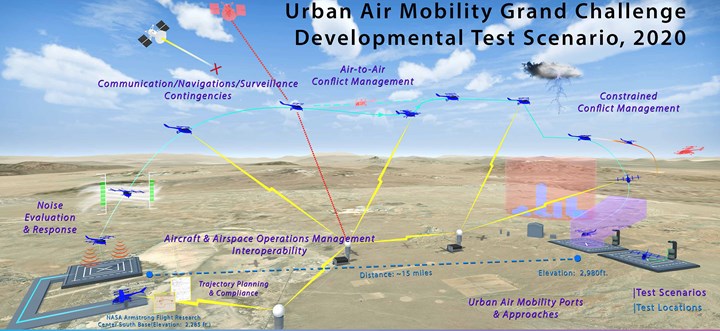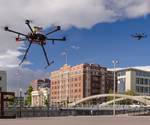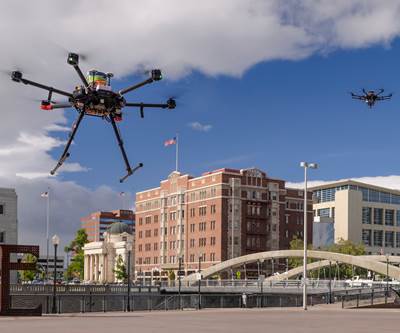NASA’s Urban Air Mobility Grand Challenge advances with agreement signings
Companies will develop or operate air vehicles and airspace management services to support larger goals in urban air mobility.

Source | NASA
As part of its Urban Air Mobility (UAM) that was announced last year, NASA (Washington, D.C., U.S.) has signed agreements with 17 companies in the aviation industry to advance plans for the first in a series of technology demonstrations. The goal of the challenge is to test the capabilities and readiness of vehicles and systems that could revolutionize mobility in and around densely populated metropolitan areas.
The NASA-led Grand Challenge series, which these new agreements support, will bring together companies intending to develop and/or operate air vehicles or airspace management services within the larger UAM ecosystem.
When fully implemented, UAM is intended to provide a safe and efficient system for passenger and cargo air transportation and could include such innovations as small package delivery within dense urban areas; personal taxi service by air; air medical services, such as patient ambulance transportation; and cargo delivery to under-serviced communities.
“With this step, we’re continuing to put the pieces together that we hope will soon make real the long-anticipated vision of smaller piloted and unpiloted vehicles providing a variety of services around cities and in rural areas,” says Robert Pearce, NASA’s associate administrator for aeronautics.
In addition to bringing together companies involved in emerging air transportation systems, the challenge intends to help ensure public safety by informing requirements for UAM operations and formalizing best practices to enable the development of regulations by the Federal Aviation Administration (FAA).
“Our partnership with the FAA will be a key factor in the successful and safe outcomes for industry that we can expect from conducting these series of Grand Challenges during the coming years,” Pearce says.

Source | NASA
The first Grand Challenge is targeted for 2022, with several developmental testing activities are planned for this year. The first step involves activities — known as the Grand Challenge Developmental Testing (GC-DT) — that will lay the groundwork for the first challenge.
The goal of the developmental test is to assess the readiness of NASA’s test infrastructure while integrating a mobile operating facility and NASA airspace services. The test will verify relevant flight test scenarios, assist in data collection and assess readiness.
So far, 17 companies have signed Space Act agreements with NASA to participate in GC-DT and activities leading up to the first Grand Challenge. With the agreements, NASA reports do not involve the exchange of funds, both NASA and the signing parties agree to provide resources to accomplish the goals of the testing.
Selected industry partners provided accepted proposals in one of three categories:
- Developmental flight testing: Industry partners will provide a vehicle to fly in the GC-DT and demonstrate key integrated operational UAM scenarios as designed by NASA’s UAM Grand Challenge team.
- Developmental airspace simulation: Industry partners will test its UAM traffic management services in robust NASA-designed airspace simulations in the GC-DT and demonstrate key integrated operational UAM scenarios.
- Vehicle provider information exchange: Industry partners and NASA will exchange information with the intent to prepare that partner for possible flight activities during the first Grand Challenge at a NASA-provided or other approved test range in 2022.
The UAM Grand Challenge is managed by the NASA’s Advanced Air Mobility project, a project office established in the agency’s Aeronautics Research Mission Directorate to coordinate all of NASA’s UAM-related activity as part of its focus to enable emerging aviation markets.
Although the deadline to participate in GC-DT has passed, NASA says that additional industry partners for the Vehicle Provider Information Exchange activity are welcome and encouraged to submit proposals. Find more information on .
Related Content
Development of a composite liquid hydrogen tank for commercial aircraft
Netherlands consortium advances cryogenic composites testing, tank designs and manufacturing including AFP, hybrid winding, welding of tank components and integrated SHM and H2 sensors for demonstrators in 2025.
Read MoreMidnight production aircraft completes full transition flight
This is Archer’s second full-scale eVTOL aircraft to achieve this milestone, critical to being able to carry commercially viable passenger payloads.
Read MoreHonda begins production of 2025 CR-V e:FCEV with Type 4 hydrogen tanks in U.S.
Model includes new technologies produced at Performance Manufacturing Center (PMC) in Marysville, Ohio, which is part of Honda hydrogen business strategy that includes Class 8 trucks.
Read MorePlant tour: Hexagon Purus, Kassel, Germany
Fully automated, Industry 4.0 line for hydrogen pressure vessels advances efficiency and versatility in small footprint for next-gen, sustainable composites production.
Read MoreRead Next
Urban air mobility: The action heats up
Columnist Dale Brosius reflects on the current state of the under-development urban air mobility (UAM) market, where it’s headed, and what it all means for the composites industry.
Read MoreNASA announces urban air mobility challenge
NASA’s UAM Grand Challenge will be a full field demonstration in an urban environment to test the readiness of UAM vehicles and airspace operator systems.
Read MoreUltrasonic welding for in-space manufacturing of CFRTP
Agile Ultrasonics and NASA trial robotic-compatible carbon fiber-reinforced thermoplastic ultrasonic welding technology for space structures.
Read More.jpg;width=70;height=70;mode=crop)










